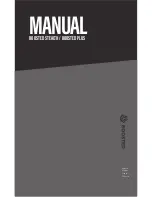
3
Description of
operation
Overcurrent unit
The overcurrent unit of the combined overcur-
rent and earth-fault relay module SPCJ 4D28 is
designed to be used for single-phase, two-phase
and three-phase overcurrent protection. The
overcurrent unit includes three overcurrent
stages: a low-set stage I>, a high-set stage I>> and
a superhigh-set stage I>>>.
An overcurrent stage starts if the current on one
or more of the phases exceeds the set start value
of the concerned stage. On starting the stage
provides a start signal which can be routed to the
desired output relay. At the same time a numeri-
cal code indicating starting appears on the dis-
play. Should the duration of the overcurrent
situation exceed the set operate time of the stage
at definite time operation or, at inverse time
operation of stage I>, a time depending on the
level of the measured current, the stage operates
issuing an operate signal, which can be routed to
the desired output relay.
The operation of the overcurrent stages I> and
I>> can be inhibited by an external control
signal BS1, BS2 or RRES(BS3) applied to the
relay module. The external blocking signals are
configured with switchgroups SGB1...3.
The operation of the overcurrent stage I> can be
based on definite time or inverse time character-
istic. When inverse time characteristic is se-
lected four internationally standardized and two
special type time/current curves are available.
Both the mode of operation and the desired
time/current curve is selected with switchgroup
SGF1.
Note! At inverse time characteristic the effective
setting range of the low-set overcurrent stage is
0.5…2.5 x I
n
, although start current settings
within the range 2.5…5.0 x I
n
can be set on the
relay. At inverse time characteristic any start
current setting above 2.5 x I
n
of the low-set stage
will be regarded as being equal to 2.5 x I
n
.
If the high-set stage I>> is given a setting from
the lower part of the the setting range, the relay
module will contain two nearly identical opera-
tion stages. In this case the relay module SPCJ
4D28 can be used in two-stage load shedding
applications.
The set start current value I>>/I
n
of stage I>>
can be automatically doubled in a start situa-
tion, i.e. when the object to be protected is
connected to the network. Thus a set start
current value below the connection inrush cur-
rent level may be selected for the overcurrent
stage I>>. A start situation is defined as a situa-
tion where the phase currents rise from a value
below 0.12 x I> to a value above 1.5 x I> in less
than 60 ms. The start situation ends when the
currents fall below 1.25 x I>.
The I>> stage or the I>>> stage can be set out of
operation completely, if not needed. When an
overcurrent stage is set out of operation the set
start current of the stage is displayed with three
dashes "- - -".
The inverse time function of stage I> can be
inhibited, when stage I>> or stage I>>> is start-
ing, in which case the operate time is deter-
mined by these stages.
Earth-fault unit
The earth-fault unit of the combined overcur-
rent and earth-fault relay module SPCJ 4D28 is
provided with two protection stages: a low-set
neutral overcurrent stage I
0
> and a high-set
neutral overcurrent stage I
0
>>.
The low-set stage or the high-set stage starts, if
the neutral or residual current measured exceeds
the set start current of the concerned stage. On
starting the stage provides a start signal, which
can be routed to the desired output relay. At the
same time a numerical code indicating starting
appears on the display. Should the duration of
the neutral overcurrent situation exceed the set
operate time of the stage at definite time opera-
tion or, at inverse time operation of stage I
0
>, a
time depending on the level of the measured
current, the stage operates issuing an operate
signal, which can be routed to the desired out-
put relay.
The operation of the overcurrent stages I
0
> and
I
0
>> can be inhibited by an external control
signal BS1, BS2 or RRES(BS3) applied to the
relay module. The external blocking signals are
configured with switchgroups SGB1...3.
The operation of the low-set stage I
0
> can be
based on definite time or inverse time character-
istic. When inverse time characteristic is se-
lected four internationally standardized and two
special type time/current curves are available.
Both the mode of operation and the desired
time/current curve is selected with switchgroup
SGF1.
The I
0
>> stage can be set out of operation
completely, if not needed. When a neutral over-
current stage is set out of operation the set start
current of the stage is displayed with three
dashes "- - -".
The inverse time function of stage I
0
> can be
inhibited, when stage I
0
>> is starting, in which
case the operate time is determined by stage
I
0
>>.
Summary of Contents for SPAA 341 C /E351
Page 130: ......
















































